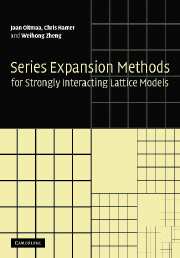Book contents
- Frontmatter
- Contents
- Preface
- 1 Introduction
- 2 High- and low-temperature expansions for the Ising model
- 3 Models with continuous symmetry and the free graph expansion
- 4 Quantum spin models at T = 0
- 5 Quantum antiferromagnets at T = 0
- 6 Correlators, dynamical structure factors and multi-particle excitations
- 7 Quantum spin models at finite temperature
- 8 Electronic models
- 9 Review of lattice gauge theory
- 10 Series expansions for lattice gauge models
- 11 Additional topics
- Appendix 1 Some graph theory ideas
- Appendix 2 The ‘pegs in holes’ algorithm
- Appendix 3 Free graph expansion technicalities
- Appendix 4 Matrix perturbation theory
- Appendix 5 Matrix block diagonalization
- Appendix 6 The moment–cumulant expansion
- Appendix 7 Integral equation approach to the two-particle Schrödinger equation
- Appendix 8 Correspondences between field theory and statistical mechanics
- Appendix 9 Computer programs
- Bibliography
- Index
Appendix 9 - Computer programs
Published online by Cambridge University Press: 06 January 2010
- Frontmatter
- Contents
- Preface
- 1 Introduction
- 2 High- and low-temperature expansions for the Ising model
- 3 Models with continuous symmetry and the free graph expansion
- 4 Quantum spin models at T = 0
- 5 Quantum antiferromagnets at T = 0
- 6 Correlators, dynamical structure factors and multi-particle excitations
- 7 Quantum spin models at finite temperature
- 8 Electronic models
- 9 Review of lattice gauge theory
- 10 Series expansions for lattice gauge models
- 11 Additional topics
- Appendix 1 Some graph theory ideas
- Appendix 2 The ‘pegs in holes’ algorithm
- Appendix 3 Free graph expansion technicalities
- Appendix 4 Matrix perturbation theory
- Appendix 5 Matrix block diagonalization
- Appendix 6 The moment–cumulant expansion
- Appendix 7 Integral equation approach to the two-particle Schrödinger equation
- Appendix 8 Correspondences between field theory and statistical mechanics
- Appendix 9 Computer programs
- Bibliography
- Index
Summary
Various computer programs have been referred to in the text and used to obtain some of the results presented in the preceding chapters. These programs can be accessed at www.cambridge.org/978052184242. This Appendix lists the various programs, together with a paragraph or two about each one.
The programs are written in fairly old-fashioned FORTRAN, and have been tested and used in our work over the years. They are relatively efficient and, as a result, not always as transparent as they might be. We attempt to point out particularly subtle sections when these occur. However we do not claim the ultimate in efficiency or complete freedom from ‘bugs’. Readers are invited to let us know of any.
A few comments on programming style are worth making. Some may prefer a single program of tens of thousands of lines which essentially does everything and covers all possible cases. In our view this is generally both inefficient and is difficult to adapt to particular problems. Our preference is for maximum modularity where a problem is broken down into different parts which are performed sequentially. This does lead to greater overheads, requiring storage of intermediate results, but has major advantages in efficiency, flexibility, and transparency.
The programs dealing with graph generation and counting are largely based on programs written by Dr C. J. (Chuck) Elliott at the University of Alberta in the early 1970s and we gratefully acknowledge this.
- Type
- Chapter
- Information
- Series Expansion Methods for Strongly Interacting Lattice Models , pp. 307 - 310Publisher: Cambridge University PressPrint publication year: 2006



